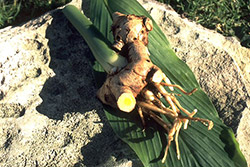Botanical name
Turmeric plant - Curcuma longa L. (Syn. Curcuma domestica Valeton)
Javanese turmeric - Curcuma zanthorrhiza Roxb.
Family
Zingiberaceae
Common name
Turmeric, Indian saffron, Curcuma
Information about the plant
India, more precisely the area of Bihar, is believed to be the original home of turmeric (C. longa). Even today, India is the main cultivation area for the plant, but it can also be found cultivated in other tropical parts of Asia. Javanese turmeric (C. zanthorrhiza) is native to tropical Southeast Asia and is cultivated in Indonesia, especially Java, Malaysia, and southern China.
The genus name Curcuma, also adopted into German as Kurkuma, goes back to the ancient Indian 'kunkuman' (= saffron), which became 'kurkuma' in Middle Indian. The Arabic word 'kurkum' (= saffron) is also used. This refers to the saffron-yellow color of the rhizomes (underground shoots) that is characteristic of both species, a characteristic further emphasized by the species epithet zanthorrhiza (formerly xanthorrhiza), derived from the Greek 'xanthos' (= yellow) and 'rhiza' (= root). The species epithet longa refers to the long secondary rhizomes of this plant, which grow diagonally downwards in a finger shape.
Both plants are very similar to ginger (Zingiber officinale), which belongs to the same plant family. The large, ovate-lanceolate leaves are basal and can reach up to 1.20 m in height with a long stem. The leaf venation is parallel. The year-old inflorescence, with several flowers, has a cone-like shape and measures about 10 to 15 cm in length and 5-7 cm in diameter. This inflorescences is enclosed in one of the sheath-like petioles, with a 15 to 20 cm long stem. The individual flowers in are yellow, and purple or crimson in C. zanthorrhiza.
The bulbous, finger-shaped, yellow rhizome of the plant is used. It is harvested when the aerial parts have withered. For C. longa, the main tuberous roots are used as cuttings for new crops, while the finger-shaped or cylindrical rhizomes are immediately blanched in boiling water to prevent sprouting during drying. For C. zanthorrhiza, the tuberous rhizomes are peeled, sliced, and then dried at 50°C. The powdered rhizomes are a hot spice and a major ingredient in curry powder.
Medicinally used parts of plants (herbal drug)
The dried rhizomes are used. Curcuma root (C. longa – Curcumae longae rhizoma) is imported from China, India, and Indonesia, while Javanese turmeric (C. zanthorrhiza – Curcumae zanthorrhizae rhizoma) comes exclusively from Indonesia.
Constituents of the herbal drug
The rhizomes of both curcuma plants contain spicy curcuminoids (dicinnamoylmethane), curcumin (yellow pigments), essential oils, and plenty of starch.
Quality of the drug
The quality of curcuma rhizome (Curcumae longae rhizoma) and Javanese turmeric (Curcumae zanthorrhizae rhizoma) is specified in the European Pharmacopoeia (Ph. Eur.).
Medical applications
Recognised medical use
The HMPC has classified curcuma rhizome and Javanese turmeric as traditional herbal medicinal products (see "Traditional use").
Indications for curcuma rhizome and Javanese turmeric supported by clinical data (marketing authorization): Digestive complaints, especially in functional disorders of the efferent biliary system, also in dyspeptic complaints.
ESCOP (curcuma rhizome): for the symptomatic treatment of mild digestive complaints and mild hepatobiliary complaints.
Traditional use
The HMPC has classified curcuma rhizome and Javanese turmeric as traditional herbal medicinal products (Article 16a of Directive 2001/83/EC). Based upon long-standing use, curcuma rhizome and Javanese turmeric can be used for relief of mild problems with digestion, such as feelings of fullness, slow digestion and flatulence.
Herbal drug preparations in finished dosage forms
- Coarsely pulverized curcuma rhizome and Javanese turmeric as a tea
- Dried extract of both drugs in capsules, tablets and coated tablets
- Aqueous extract in drops
Dosage
Prepared drugs: see patient information leaflet.
Tea: drink a cup of tea several times a day, before or with meals. Daily dose: 1.5 g to 3 g of powdered drug.
Preparation of a tea
Pour 150ml of boiling water over 0.5 to 1g coarsely powdered Curcuma rhizome or Javanese turmeric and strain after 5 to 10 min.
Notes
In case of biliary obstruction or inflammation, gallstones, or biliary and liver disease, curcuma rhizome or Javanese turmeric may not be taken. If the symptoms persist for longer than 2 weeks or worsen, seek medical advice immediately.
There are no studies on the safety of the use of curcuma rhizome or Javanese turmeric during pregnancy and lactation, as well as for use in children and adolescents under 18 years of age.
Side effects
Sometimes stomach discomfort; dry mouth and flatulence may also occur.
Interactions
None known
References
Herbal drug monographs
HMPC (2014, 2019), ESCOP (2003, 2009), WHO Vol. 1
Further literature
Commentary on the European Pharmacopoeia (Curcuma rhizome, No. 2543; Javanese turmeric, No. 1441)


